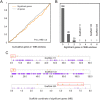Positively selected genes in the hoary bat (Lasiurus cinereus) lineage: prominence of thymus expression, immune and metabolic function, and regions of ancient synteny
- PMID: 35317076
- PMCID: PMC8934532
- DOI: 10.7717/peerj.13130
Positively selected genes in the hoary bat (Lasiurus cinereus) lineage: prominence of thymus expression, immune and metabolic function, and regions of ancient synteny
Abstract
Background: Bats of the genus Lasiurus occur throughout the Americas and have diversified into at least 20 species among three subgenera. The hoary bat (Lasiurus cinereus) is highly migratory and ranges farther across North America than any other wild mammal. Despite the ecological importance of this species as a major insect predator, and the particular susceptibility of lasiurine bats to wind turbine strikes, our understanding of hoary bat ecology, physiology, and behavior remains poor.
Methods: To better understand adaptive evolution in this lineage, we used whole-genome sequencing to identify protein-coding sequence and explore signatures of positive selection. Gene models were predicted with Maker and compared to seven well-annotated and phylogenetically representative species. Evolutionary rate analysis was performed with PAML.
Results: Of 9,447 single-copy orthologous groups that met evaluation criteria, 150 genes had a significant excess of nonsynonymous substitutions along the L. cinereus branch (P < 0.001 after manual review of alignments). Selected genes as a group had biased expression, most strongly in thymus tissue. We identified 23 selected genes with reported immune functions as well as a divergent paralog of Steep1 within suborder Yangochiroptera. Seventeen genes had roles in lipid and glucose metabolic pathways, partially overlapping with 15 mitochondrion-associated genes; these adaptations may reflect the metabolic challenges of hibernation, long-distance migration, and seasonal variation in prey abundance. The genomic distribution of positively selected genes differed significantly from background expectation by discrete Kolmogorov-Smirnov test (P < 0.001). Remarkably, the top three physical clusters all coincided with islands of conserved synteny predating Mammalia, the largest of which shares synteny with the human cat-eye critical region (CECR) on 22q11. This observation coupled with the expansion of a novel Tbx1-like gene family may indicate evolutionary innovation during pharyngeal arch development: both the CECR and Tbx1 cause dosage-dependent congenital abnormalities in thymus, heart, and head, and craniodysmorphy is associated with human orthologs of other positively selected genes as well.
Keywords: Adaptation; Cat-eye critical region; Chrna9; Conserved synteny; Hoary bat; Immunogenetics; Positive selection; Tbx gene family; Thymus.
© 2022 Cornman and Cryan.
Conflict of interest statement
The authors declare that they have no competing interests.
Figures





Similar articles
-
A genomic hotspot of diversifying selection and structural change in the hoary bat (Lasiurus cinereus).PeerJ. 2024 May 31;12:e17482. doi: 10.7717/peerj.17482. eCollection 2024. PeerJ. 2024. PMID: 38832043 Free PMC article.
-
Seasonally-Dynamic Presence-Only Species Distribution Models for a Cryptic Migratory Bat Impacted by Wind Energy Development.PLoS One. 2015 Jul 24;10(7):e0132599. doi: 10.1371/journal.pone.0132599. eCollection 2015. PLoS One. 2015. PMID: 26208098 Free PMC article.
-
Continental-scale, seasonal movements of a heterothermic migratory tree bat.Ecol Appl. 2014 Jun;24(4):602-16. doi: 10.1890/13-0752.1. Ecol Appl. 2014. PMID: 24988763
-
Acoustic and Genetic Data Can Reduce Uncertainty Regarding Populations of Migratory Tree-Roosting Bats Impacted by Wind Energy.Animals (Basel). 2021 Dec 30;12(1):81. doi: 10.3390/ani12010081. Animals (Basel). 2021. PMID: 35011186 Free PMC article. Review.
-
Evolutionary escalation: the bat-moth arms race.J Exp Biol. 2016 Jun 1;219(Pt 11):1589-602. doi: 10.1242/jeb.086686. J Exp Biol. 2016. PMID: 27252453 Review.
Cited by
-
Different Species of Bats: Genomics, Transcriptome, and Immune Repertoire.Curr Issues Mol Biol. 2025 Apr 7;47(4):252. doi: 10.3390/cimb47040252. Curr Issues Mol Biol. 2025. PMID: 40699651 Free PMC article. Review.
-
A genomic hotspot of diversifying selection and structural change in the hoary bat (Lasiurus cinereus).PeerJ. 2024 May 31;12:e17482. doi: 10.7717/peerj.17482. eCollection 2024. PeerJ. 2024. PMID: 38832043 Free PMC article.
References
-
- Adams RA, Pedersen SC. Bat evolution, ecology, and conservation. Berlin: Springer; 2013.
-
- Arnaout MA. Structure and function of the leukocyte adhesion molecules CD11/CD18. Blood. 1990;75:1037–1050. - PubMed
-
- Ballinger MA, Hess C, Napolitano MW, Bjork JA, Andrews MT. Seasonal changes in brown adipose tissue mitochondria in a mammalian hibernator: from gene expression to function. American Journal of Physiology-Regulatory, Integrative and Comparative Physiology. 2016;311(2):R325–R336. doi: 10.1152/ajpregu.00463.2015. - DOI - PubMed
MeSH terms
LinkOut - more resources
Full Text Sources
Miscellaneous

